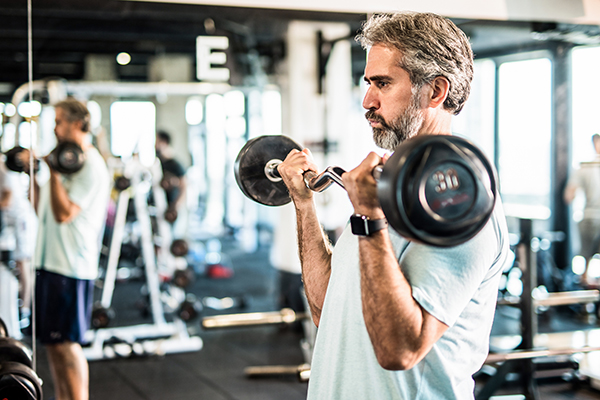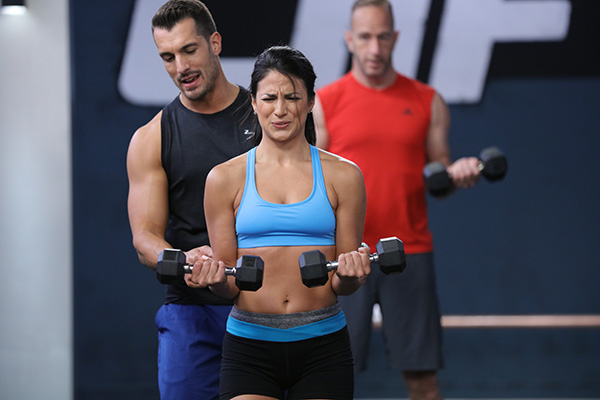What Is Progressive Overload?

No one starts their fitness journey with the ability to lift really heavy weights or easily complete multiple sets of a challenging exercise.
In order to turn those five-pound bicep curls into 10-pound curls and beyond, you have to challenge your muscles so they can adapt to heavier work. One of the most effective ways to advance your fitness endeavors is to follow the process of progressive overload.
Here’s how it works, and why it will help you reach your goals safely and efficiently.
What Is Progressive Overload?
Progressive overload refers to the process of gradually overloading the body with either volume, intensity, frequency, or time to reach a specific goal.
“In other words, by teaching your body to do more work, you force new adaptations to become efficient at the demands you place on your system,” says Cody Braun, CPT.
The Benefits of Progressive Overload

As one of the foundational principles of exercise science, progressive overload is a safe and time-efficient way to achieve new strength gains and change your body composition over time.
“Once the body becomes accustomed to the demands [of exercise], you will become more efficient at that task,” says Braun.
That’s why you need to make some adjustments to your routine after some time, by doing things like using heavier weights or doing more reps. Otherwise, you won’t continue to see as many benefits from your workouts.
A huge benefit of progressive overload is that it encourages positive changes safely. If you’re doing 10 reps of squats using 50 pounds one day, jumping up to 100 pounds the next day with the same number of reps is a surefire way to set yourself up for injury.
Your body needs time to adjust to new demands and to build up the strength to appropriately handle new weight.
That’s why it’s called progressive overload: it helps you improve over time, step by step.
Besides the physical effects, your brain also gets a boost from progressive overload. Doing the same workout every day gets boring and doesn’t challenge you mentally.
Tweaking your workout routine every so often can help keep you engaged and interested in what you’re doing, which ultimately impacts the amount of effort you put into your workouts.
How to Use Progressive Overload
When you start working out, the first thing you should focus on is perfecting your form with efficiency, Braun says.
“Before you move from one stressor to the next, you want to become efficient,” he advises. “Once you can move well, then you can play with rep ranges, rest time, weight, intensity, total volume, and frequency.”
Joe Cannon, MS CSCS, NSCA-CPT, often advises beginners to use progressive overload in three phases. First increase the reps, then the number of sets, and then the weight.
What is an example of progressive overload?
Let’s say you start a workout program where you perform 10 reps of biceps curls with a five-pound weight for three sets. During the first week, this is challenging, and the final two reps are difficult.
By the end of the second week, you finish the 10th rep with no problem at all. According the progressive overload principle, you would then want to do 12 reps of curls with the same five-pound weight for three sets.
After that becomes manageable, keep the same weight, and add in a fourth set.
At the point when that becomes a breeze is when you should reset and increase the weight: Now you’re doing 10 reps with a 10-pound weight for three sets.
That’s an example of progressive overload in weight training, but you can use the same concept in other kinds of workouts too.
If you’re doing a running workout, you can play around with aspects like how many sprint sets you do, how long the sets are, and how long you rest in between the sets.
As long as you’re challenging your body more and more, little by little, you can keep your body adapting and improving.
Not sure where to start? Find a program to follow. The good ones will incorporate progressive overload into the schedule by varying the complexity of exercises, work-to-rest ratios, overall duration, and intensity.
Do I Have to Progress Every Workout?

You probably won’t progress every workout — and that’s OK.
“Progression is not always a straight shot,” Braun says. If you’re a beginner, you’ll likely go through periods when you easily increase your strength.
But once you get past the beginning stages, you’ll likely see a slowdown in how quickly you can jump up in weight or sets.
“The body can be unpredictable at times,” Braun says, so you need to keep adjusting your routine to figure out what works best for you.
The good news is that your body will get over these temporary plateaus and you’ll continue to see positive changes in your body, your strength, and your confidence.
